Best gaming microphones 2024: top USB and XLR mics for streaming
Tested and recommended by Digital Foundry.
If you want to begin their journey of creating content for YouTube or streaming games on Twitch, one of most essential bits of kit to pick up is a solid USB or XLR microphone. A dedicated microphone is likely to offer clearer and more fuller audio than what you can get from a headset, and it doesn't have to cost an arm and a leg either. To help you find something that suits your needs, we've tested the most popular USB and XLR mics available to find the best of the best.
W've split our choices down into mics for specfic needs, be it the best for recording voiceovers, or the best for streaming. We've also broken XLR microphones off into their own separate categories, given these are a little more technical than plug-and-play USB choices but can offer a substantial boost in quality and flexibility.
On the front of prices, all of the mics we've picked retail for below £200/$200, and although the world of audio can get more expensive, we're focusing on mics for those who are just getting started. If you want to upgrade later down the line for something more expensive and pro-grade, then you certainly can. To help you out even more, we also picked runner-up options for a few categories to recognise good alternatives that may be preferred by some people.
With that out of the way, let's get into the selections. We'll start with a brief summary of our five favourites. Click the links below to jump to that entry, or just scroll down to read our selections in full.
Best gaming microphones 2024
- Best USB mic for streaming: Elgato Wave 3
- Best USB mic for recording and podcasting: Blue Yeti X
- Best XLR mic: PreSonus PD-70
- Best cheap XLR mic: 512 Audio Limelight
- Best premium XLR mic: Shure SM7B
- Best USB mic for ease of use: NZXT Capsule
- Best cheap USB mic: Blue Snowball Ice
- Best audio interface for streamers: Elgato Wave XLR
- Best headset mic: Antlion Audio ModMic USB
Best USB mic for streaming: Elgato Wave 3
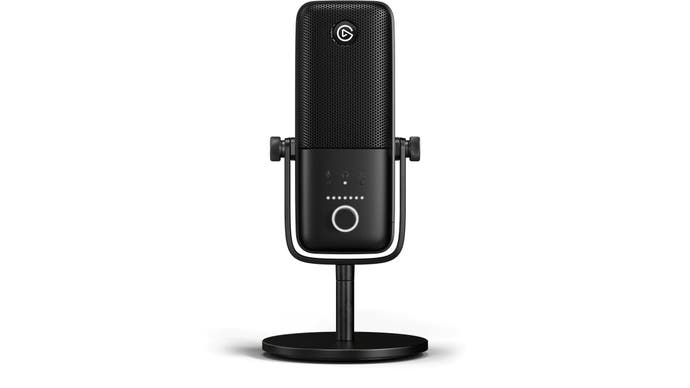
- Best-in-class software and integration with good usability
- Integrated eight-channel mixer is a rare feature well implemented
- Clear, no-clip cardioid recording - but no other patterns
In our best streaming accessories article, we have separate categories for "best USB mic" and "best mixer", but you could make a strong argument for the £150/$150 Elgato Wave 3 to take over both categories. That's because this mic is also a virtual mixer, thanks to the Wave Link software which allows you to adjust the mix of the mic and up to eight additional audio channels. This is great for streaming, because it makes it dead-simple to make sure your game audio, your subscriber alerts, your music and anything else running on your PC or Mac sounds properly balanced. This also integrates into the Elgato Stream Deck - either the physical devices or the phone apps - so you can control your audio settings while streaming with a tap, which is neat.
Even if you don't need the mixing features, the Wave 3 also performs well as a straight-up USB mic. One of the big reasons for this is the inclusion of a "Clipguard" feature, which effectively swaps the standard recording channel for one 20dB lower if the mic detects clipping. Both channels run all the time, so swapping between the two sounds natural and it eliminates a common pitfall for streamers. There's still a 3.5mm jack on the back for zero-latency monitoring, which is always nice to have, and the Wave 3 is powered by USB-C.
While the software experience is best-in-class, the Wave 3's hardware has been developed cleverly too. A single dial on the front can be pressed in to switch between adjusting gain, headphone volume and the mic/PC mix, while a capacitive sensor on the top allows for a one-tap mute (indicated with a clear red LED). There are no different capture patterns here, as on the Blue Yeti, but for recording a single person's speech this is no problem.
The audio we recorded came out clear and distinct, with good clarity in the mid and high frequencies if lacking a little warmth. As this is a condenser mic, you'll still pick up the clatter of mechanical keyboards if the mic is too far away from your face or the gain level is set too high. Plosives are catered for via an included shield, but a proper pop filter may still be necessary depending on how much fire you're spittin'. Finding the perfect positioning is made easier if you swap the included desk stand for a proper arm mount, via the included adapter.
Overall, the Wave 3 is a great-sounding USB mic that is easy to use and offers some intriguing possibilities for streaming thanks to its anti-clipping and audio mixing features. The cheaper Wave 1 is also available, but in most regions it seems to be nearly the same price as the Wave 3. It offers the same features, only lacking some physical controls and 96kHz recording, neither of which are significant drawbacks.
Runner-up: Roccat Torch

The £60/$70 Roccat Torch is the second-best USB microphone we've found for streaming thanks to its detailed audio and well-implemented features. There are three recording modes on offer and a physical gain slider, allowing the mic to be adapted for one audio source or multiple voices with ease. There's even a 'whisper' mode, which adds extra gain if you want to be heard without raising your voice. Being able to mute your audio quickly can be key, and here there are two ways of doing so - either clicking the volume knob on the base of the mic or waving your hand above the top of the mic. Pickup pattern, gain and mute all come with corresponding RGB effects, so you can see the current settings at a glance.
Other handy features include an internal pop filter that ensures p and b sounds don't result in an annoying pop and lag-free audio monitoring. The only real drawback is that the default stand is a little short, and you need to use two USB cables in the default configuration - one connecting the mic to the base, and the other connecting the base to your PC. I can see why Roccat has done this, as it allows the mic and base to be used together or apart, but doesn't look or feel as clean as most USB mics. Another bit of weirdness is the Roccat Neon software, which detects the Torch but doesn't provide any controls for it - just a black screen.
Another strong option is the £102/$129 HyperX QuadCast. It also has tap to mute and multiple pickup patterns, but is an all-in-one unit rather than having a separable mic and base.
Third option: Røde NT-USB Mini

The Røde NT-USB Mini is a compact USB mic with a short stand but excellent audio quality for its £78/$99 price point. Rather than offering multiple recording patterns, as with the Blue Yeti, Røde have focused on capturing the best audio they can from right in front of the mic, with recordings typically emphasising the mid-range in a manner that's pleasant for acoustic instruments or - helpfully for us - human speech.
The focus on simplicity means this mic really is plug-and-play, with no gain knob to adjust or polar patterns to select, and it works on Windows, Mac, Android and iOS over full-size USB or USB-C. The NT-USB Mini does include one very helpful extra feature though - zero-latency monitoring via 3.5mm, which is great for dialling in your sound before you go live. The included desk stand is quite short, so we do recommend picking up a simple desk mount to make sure your dulcet tones are being captured rather than the mechanical clatter of your keyboard. Overall, a great low-profile microphone that's easy to use and sounds fantastic.
Best USB mic for recording and podcasting: Blue Yeti X

- Choice of four recording patterns to suit a wide range of scenarios
- Standout audio quality that requires little cleanup
- Useful LED volume metre and extensive software options
- Will pick up background noise like keyboards if gain is too high
When it comes to streaming and podcasting, the £120/$101 Blue Yeti series is perhaps the most popular microphone in the world. Whether plunked down on a desk to be held aloft by its chunky stand or held in place on a strong boom arm, the Yeti provides strong audio quality for a range of use cases thanks to its four different recording patterns: cardioid, stereo, omnidirectional and bidirectional. The inclusion of a 3.5mm headphone jack means you can also plug in headphones to monitor exactly what the mic is hearing.
The £133/$139 Yeti X is the latest edition and includes a new LED volume metre and multi-function control knob right up front, making it easy to adjust gain to dial in the perfect levels on the fly. On the software side of things, the Blue Vo!ce section in the Logitech G Hub includes plenty of options for adjusting tone and removing annoying sonic artefacts, including presets from popular streamers. Overall, the Yeti X is a solid improvement over the standard Yeti, but if you're working to a budget the original model is still worth considering.
Runner-up: Cherry UM 6.0 Advanced
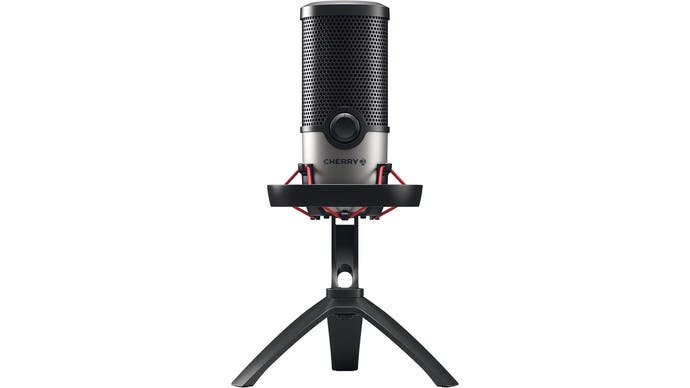
The £94/$137 Cherry UM 6.0 Advanced is not the first product you'd expect to see from Cherry, maker of mechanical switches and keyboards, but the mic is actually a good performer that picks up sufficient detail without significant handling noise. As a USB mic, it's plug-and-play without any software required, and it's good to see USB-C too.
In terms of features, the UM 6.0 Advanced offers two pickup patterns, cardioid and omni-directional, convenient tap-to-mute functionality, a gain knob on the front that you tap to change patterns, a mouse-style scroll wheel on the back to adjust monitoring volume via the 3.5mm port, and a solid metal design - including a surprisingly robust shock mount desk stand. The mic also looks solid, with a professional silver, black and red design.
As always, a pop filter and mic arm are ideal to avoid keyboard noise, handling noise and properly powerful plosives, and Cherry do offer these alongside the mic itself - though at £24/$16 for the pop filter and £66/$60 for the mic arm, you may find cheaper alternatives preferable.
Third option: Sennheiser Profile
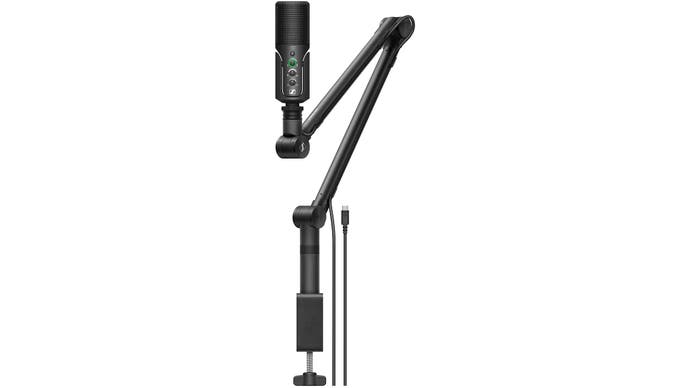
The £172/$199 Sennheiser Profile Streaming Set is another great plug-and-play solution, as it comes with not only a great mic but a matching slim boom arm that insulates the microphone from desk noise and brings it right up next to your face, where it sounds best. The mic even has a yoke design that lets it tilt a bit, which is great for fine-tuning its position after it's mounted in a mic arm.
The Profile is a fairly neutral microphone, with prominent mids, not too bright or nasally, with good off-axis noise rejection and basically zero handling noise. The controls here are comprehensive and intuitive, allowing you to get to grips with things rapidly and without needing software. There's a mute button on top that turns red when the mic is off, a gain knob that displays live levels, a mic/PC mixer for the 3.5mm headset monitoring and a headset volume knob - all very effective. On the back, you have your USB-C and 3.5mm ports. The mic as a whole feels incredibly well built and dense.
Overall, an awesome all-in-one option that doesn't wow in terms of audio quality but in terms of its features and usability - and that's fine by me.
For one more USB mic to consider, check the XLR category below for our write-up of the Audio-Technica AT2020USB-XP, a new variant of the XLR AT2020 mic.
Best XLR mic: PreSonus PD-70

- Bright, clear sound with great off-axis noise rejection
- Clean, professional appearance
- Allows entry to the complex but powerful XLR ecosystem
The £89/$99 PreSonus PD-70 is the best XLR microphone for gaming we've tested so far. It's a dynamic mic rather than a condenser, meaning it captures a little less detail but offers much better off-axis noise rejection, which can be great for streaming or recording in a busy environment where you may have other people's vocal effluence or the clatter of mechanical keyboards competing with your voice.
The PD-70 is well-built, with a clean, professional look that mirrors the popular Shure SM7B, complete with a removable wind screen helps to reduce sibilance and plosives. It sounds good right out of the box too, with a bright sound signature that improves vocal clarity and de-emphasises low rumbling background noise. Of course, you're free to tweak the mic with whatever audio interface or software you've chosen elsewhere in the chain, making it suitable for both low and high voices. As an end-address rather than a side-address microphone, I also found it a little easier to position in a desk-based streaming setup, as it can just poke out from above or to the side of a monitor and doesn't take up much of your peripheral vision. Given its affordable price, it's definitely worth considering for anyone interested in streaming games in a normal, not-always-silent space.
Runner-up: Elgato Wave DX
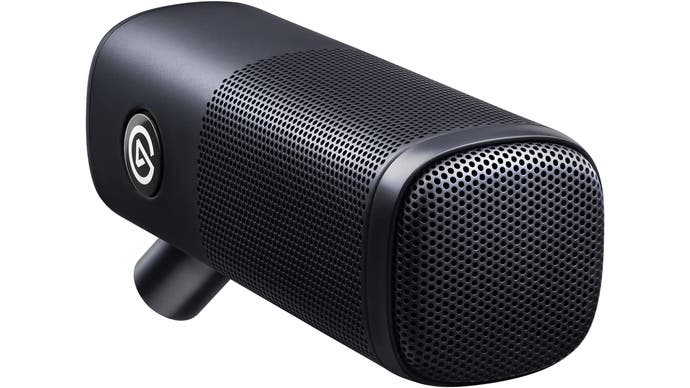
The £100/$90 Elgato Wave DX is another excellent dynamic XLR microphone at a very attractive price point. The Wave DX hits many of the same notes as the PreSonus PD-70, with a nice, bright sound signature that boosts the top end, solid off-axis sound rejection and surprisingly good resistance to plosives with its integrated pop filter. However, the mic isn't great at rejecting knocks or taps to the body of the mic or its cable, so it's best used in situations where it can remain undisturbed while broadcasting. Otherwise though, Elgato's work with Lewitt Audio appears to have be a successful collaboration.
I'm a big fan of the way the Wave DX looks, with a squircular design that hits a nice blend of boxy and tubular, rendered in black with a metal construction. You can place the mic on either side of its swivel mount, which comes with 1/4-inch, 3/8-inch and 5/8-inch threading via two removable adapters for excellent flexibility.
Overall, the Wave DX is a fantastic mic that works well out of the box, so well worth picking up - particularly if you're already interested by (or invested in) the Elgato ecosystem, eg StreamDeck, Wave XLR, Facecam and so on.
Third option: Audio-Technica AT2020
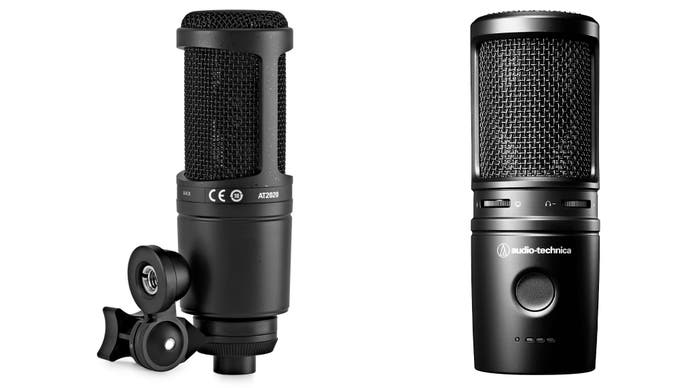
The £85/$99 Audio-Technica AT2020 is a popular entry-level XLR mic that serves as a good condenser alternative to the PD-70, offering the possibility of extremely clear audio if you're willing to put together the necessary equipment to get it running. All that comes in the box is the mic, a bag and a stand adapter, so you'll need to provide at least an XLR cable, a stand and an audio interface or mixer that provides at least 48V of phantom power. Once all of these components are in place, your reward is warm, crystal-clear audio that's ideal for recording podcasts or video voiceovers. It's worth noting that the AT2020 is fairly hefty and skews towards 'professional' rather than 'gamer' in the looks department, but that's no bad thing. As a condenser mic, you get more vocal clarity than the PD-70, but you also pick up much more off-axis noise, such as keyboard clatter, mouse clicks and so on - something to keep in mind if you're using this for streaming rather than producing voiceover.
If the AT2020 sounds attractive but you'd prefer a simpler setup or more features, then the £149/$169 AT2020USB-XP is worth considering. This is essentially a USB version of the familiar AT2020 design, which adds a USB-C connection (duh), a detachable pop filter, automatic gain control, three levels of built-in noise reduction and a touch-sensitive mute switch (that triggers blue or red lighting). 24-bit audio up to 192kHz is supported, too. This version of the mic is easier to use and still sounds great, making it a solid option - albeit one at a fairly hefty premium given that it lacks the multiple polar patterns common at this price point and in this category.
Best cheap XLR mic: 512 Audio Limelight
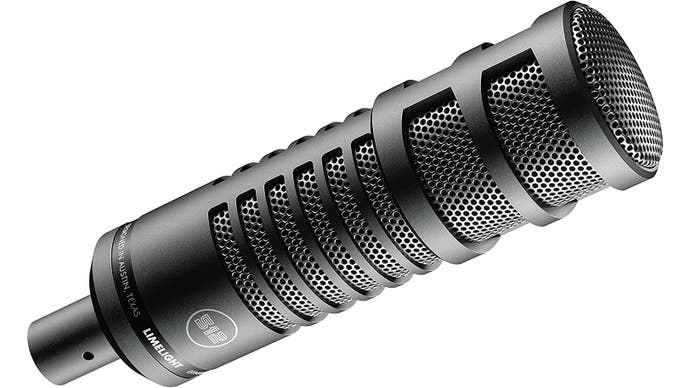
The £76/$70 512 Audio Limelight is the best budget XLR mic we've found. It's along similar lines to the Shure SM7B, in that it's a dynamic XLR mic with a broadcast-friendly sound. The Limelight has the tendency to get a bit boomy when you're too close, but back off a touch and you get a nice deep and dark sound - a great example of the proximity effect in action. The mic includes two modes, 'flat' and 'low cut', but the second mode sounds a bit anaemic in comparison and didn't suit my voice at all. Thankfully, the mode selector is completely inaccessible with the default 360-degree grip attached so leaving it on the default is at least straightforward.
As with many other dynamic mics, it requires no phantom power and does a better job at capturing only on-axis sound compared to condenser microphones. Right now, the PreSonus PD70 feels like the better value, offering better out-of-the-box sound without so much handling noise at a lower price point... but the Limelight is also worth investigating. As always, we recommend checking out a plurality of reviews and write-ups in order to get a balanced picture on this promising first microphone from a new audio brand.
Best premium XLR mic: Shure SM7B
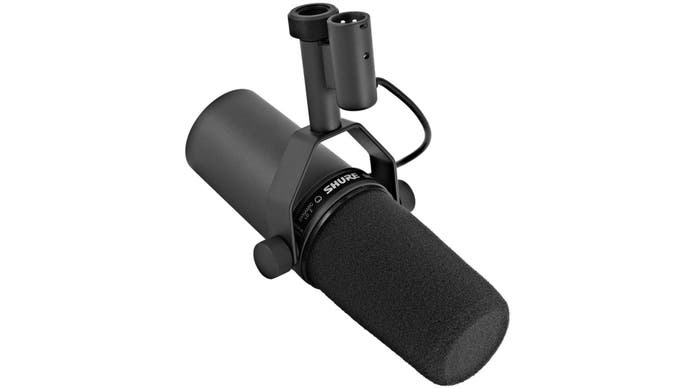
The £379/$399 Shure SM7B is a legendary XLR dynamic microphone that's been recommended for podcasters, streamers and audio professionals for years due to its smooth, dark and accurate sound for vocals, its excellent build quality and overall reliable performance. (The original SM7 was released 50 years ago with an extremely similar design.) Its cardioid pickup pattern is great at rejecting off-axis sounds, and it's quite resistant to handling noise too.
Flat, bass roll-off and presence boost modes, accessible via switches on the back of the mic, allow you to control the mic's sound signature before it arrives at your audio interface. The overall appearance is professional, with metal construction and excellent build quality. I love the clever way the XLR input is routed on the same axis as the thread-mount, which simplifies positioning your XLR cable.
The only real downside is that it does require a relatively powerful audio interface, like the Elgato Wave XLR, as weaker options like the FocusRite Scarlett 2i2 benefit from the inclusion of a Cloud Lifter or similar booster to ensure that you don't end up maxing out your audio interface's gain.
Overall, it's clear why so many people have used and recommended this mic - it simply delivers reliably great audio, with a thoughtful design and no real drawbacks when used with a good audio interface.
Runner-up: Logitech Blue Sona
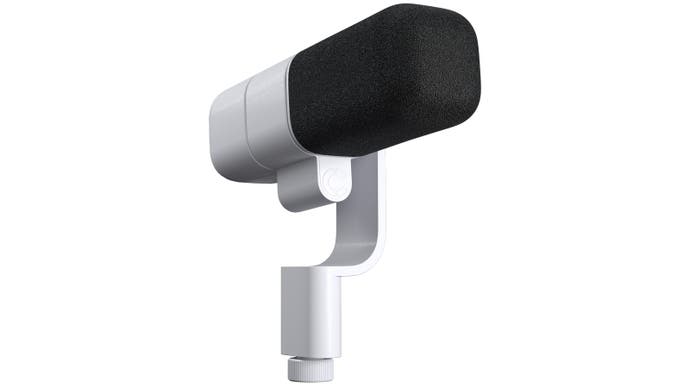
The £286/$349 Blue Sona from Logitech is a genuinely great XLR dynamic microphone with a supercardioid pickup pattern, built-in pre-amp, impressive off-axis noise rejection and a dark, smooth and detailed sound.
These qualities makes the Sona a good alternative to the SM7B, and although it requires 24V or 48V phantom power, its pre-amp means that you don't need to employ a Cloud Lifter or similar to get usable volumes without maxing out gain, even on relatively underpowered audio interfaces like the FocusRite Scarlett 2i2.
The Blue Sona looks the part too, with a beautiful, nearly all-metal construction with the body of the microphone in the shape of a modern squircular prism (definitely an accepted term). A magnetic plate on the back of the mic that can be popped off to reveal bass-cut and presence switches. Finally, there are white and black colour options, and both black and red mic shields included in the box alongside a 1/4th-inch and 5/8th-inch adapter for mounting the mic to an arm.
Logitech does tend to be a bit more aggressive with their pricing than the likes of Shure, as is the case at the time of writing, and as a cheaper SM7B alternative that delivers much of the same vocal characteristics with a more modern look, it's a great pickup.
Best cheap USB mic: HyperX DuoCast

- Great audio quality with two pickup patterns
- Plug-and-play USB operation, optional Ngenuity software
- Long feature list for the price: shock mount, tap-to-mute, gain knob, 3.5mm monitoring, USB-C and RGB
If you've only got £70/$70 to put toward upgrading your recording setup, the HyperX DuoCast provides an impressive feature list and good recording quality at its price point.
The DuoCast features two pick-up patterns, versus four for the QuadCast above, but cardioid and omnidirectional cover most use cases just fine and up to 24-bit 96kHz recording is supported. They capture a lot of detail but also a fair amount of background noise, though this is lessened when you mount it on an arm rather than the too-short desk stand. The included shock mount and pop filter work impressively well, and the combination of a tap-to-mute top and a rear gain knob make it easy to dial in your levels. A USB-C connection and 3.5mm port for mic monitoring is also provided.
The mic works well out of the box, but you can optionally install HyperX's Ngenuity software to make basic changes. Finally, the microphone looks great, with a matte black colour scheme and (optional) RGB lighting, though its plastic construction means it doesn't feel quite as robust as something more expensive, like Sennheiser's Profile mic or Cherry's UM 6.0 Advanced mic.
Runner-up: Trust GXT 258 Fyru

- Convenient pattern, gain and volume controls, plus live monitoring
- Cool streamer-friendly appearance, with LED surround lighting
- Good cheaper alternative to Blue Yeti for European buyers
While the Blue Snowball is a great budget choice, the £29 Trust GXT 258 Fyru is another strong alternative. Unlike the Snowball, it provides a choice of four recording patterns, so you can record in an interview or group podcast format easily. The current pattern is indicated clearly on the top of the mic, with lit LEDs signifying active microphones. There's also some LED backlighting within the sheath, which looks cool in photos or on stream without being too distracting. Gain controls and live 3.5mm monitoring are also offered, which is nice. The mic comes with a simple desk stand which works well, and can also be affixed on any arm with a standard thread mount. There's a lot to like here, not least the audio quality which feels close to the Yeti standard.
Third option: HyperX SoloCast
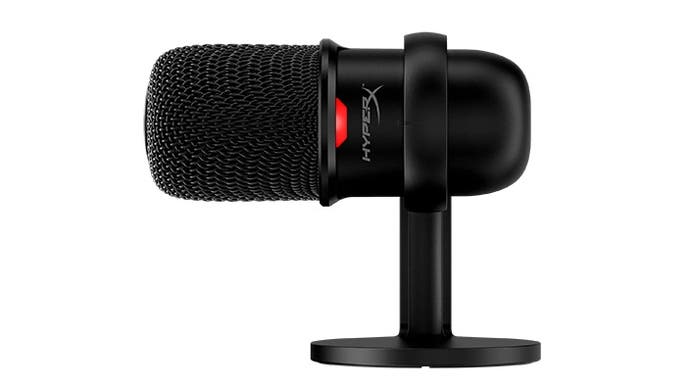
Another option, this time available in both the US and UK, is the £50/$40 HyperX SoloCast. As the name suggests, this mic only offers a single cardioid pattern, compared to the four built into the more expensive QuadCast. That makes the mic a little less flexible, but audio quality remains good and the tap-to-mute functionality we loved on the original mic remains. The overall appearance is more sober here, with only a single red LED to indicate the mic's status, making it a little better at blending in on video. The included stand is very short, so we recommend using the screw mount on the bottom with a mic arm for best results. Overall, a solid option at its price point.
Best USB mic for ease of use: NZXT Capsule
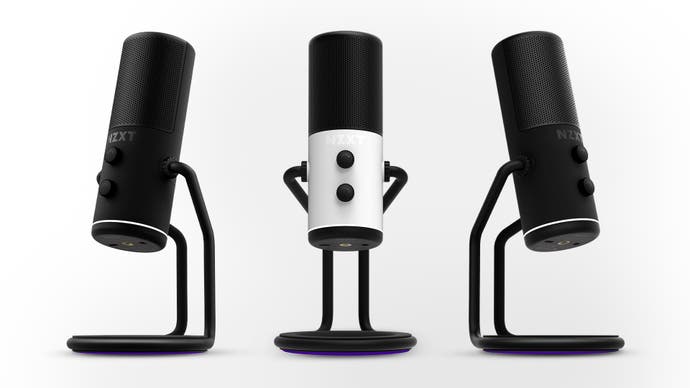
- Extremely simple operation, plug and play with no software
- Detailed audio pickup, albeit not the cleanest we've heard
- No way to see gain at a glance
The £53/$86 NZXT Capsule aims for simplicity, with plug-and-play operation and no software to confound things. This is great in some respects, as it means that you can just connect the mic via USB, check your levels in your favourite streaming software while fiddling with the gain and monitoring volume levels, and then start immediately. However, it also means that you don't get the option of multiple pickup patterns to suit a wider range of use cases, and sometimes it's reassuring to have a piece of software for your new gadget that helps you install firmware updates, check the current settings and so on.
I love the clean look of the Capsule in white, which meshes nicely with NZXT's range of cases, motherboards and peripherals, including the matching Boom Arm (linked below). However, the minimalist aesthetic also means that you have to remember which dial does what - the symbols on it are meaningless and impossible to read from a distance - and there's no way to see how much gain you've got as the dial spins forever and there's no lighting or software readout as there is with the HyperX Quadcast or Roccat Torch. The Capsule is at least robustly constructed, as you'd hope from a £110/$130 product.
Thankfully, the small annoyances here are made up by the mic's quality - the sound captured is quite detailed and needs minimal processing, the desk stand is stable and a ⅜-inch adapter is provided for boom arms. Other mics do sound better out of the box, so NZXT's tuning here could be improved, but for casual streamers it's an easy upgrade over a headset mic or a cheap-o USB mic. This is NZXT's first audio product that I'm aware of, so hopefully we see a version two down the line that fixes some of these small issues while hitting the same 'plug-and-play simplicity' brief.
If you prefer a physically smaller microphone, we've also tested the Capsule Mini. It stands at just 18.5cm with stand, compared to 25.3cm for the full-size Capsule. Build quality is reasonable, with a plastic frame and a similar minimalistic aesthetic, but there's only a singular rubberised dial on the front for gain control - so no on-board monitoring volume adjustment. The Mini also misses out on the bigger Capsule's quick release stand, instead relying on undoing a couple of screws on the curved desk stand to slot elsewhere, such as on the Boom Arm Mini. You may want to opt for a proper arm too, as even a slight knock on the desk stand can send it flying. Inputs on the bottom are the same as the Capsule, with a USB-C for power, and a 3.5mm jack for monitoring.
While you lose out on some hardware features, you get the same single cardioid pickup pattern which delivers clean and clear audio from a closer range. There's solid body to it, and an internal pop filter does a reasonable job of eliminating plosives. Software support is basic, and handled by NZXT's all-in-one CAM software they use for all components and peripherals. You simply get three volume indicators to change, for the mic's gain, monitoring volume and sidetone - ie the level of your own voice you hear in your headset - and sound presets for different content types.
While you might reasonably expect a smaller mic with fewer features to cost less, the Mini's $30 lower MSRP in the US is made up for by post-launch price cuts to the full-size Capsule on retailers like Amazon. Meanwhile, in the UK, the two mics have the same exact price on NZXT's official store. Therefore, we recommend the full-size Capsule over the Mini unless you specifically require a lower-profile option or the Mini is significantly cheaper in your region.
Best audio interface for streamers: Elgato Wave XLR
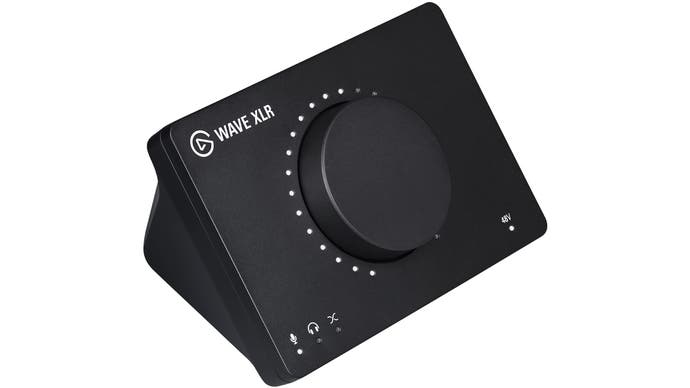
- Simple all-in-one audio interface and mixing solution in compact form factor
- Enough power to drive a Shure SM7B
- Works well with Elgato's Stream Deck, Wave microphones and other components
The £145/$160 Elgato Wave XLR is the most convenient all-in-one audio interface we've tested for streamers, offering 48V of phantom power to XLR microphones and up to 75dB of gain to drive almost all mics on the market.
The Wave XLR is easy to use and takes up minimal desk space, with a single large wheel used to adjust mic gain, headphone volume and crossfading. While the Wave XLR lacks the huge spread of controls provided by our previous pick, the GoXLR, the £159/$150 Stream Deck and £198/$200 Stream Deck Plus can be used in tandem with the Wave XLR if needed - and Elgato continue to develop the platform, unlike TC Helicon with the now-abandoned GoXLR.
The impressive audio hardware are backed up by a powerful and intuitive Wave Link software that allows microphones to be dialled in and various processing to be done with VSTs to keep your voice sounding just the way you want it. You can also adjust how audio is routed around your PC, eg you can set your game to one audio device, your mic to another, your chat to another and so on. The ClipGuard feature runs a second audio stream at a lower gain setting simultaneously, with the Wave XLR automatically swapping to this stream if clipping is detected - a lifesaver for critical recordings.
While the Wave XLR is powerful, it only has a single mic input, so you may be better off with an interface with multiple XLR inputs if you want to institute a multi-mic setup.
Best headset mic: Antlion Audio ModMic USB
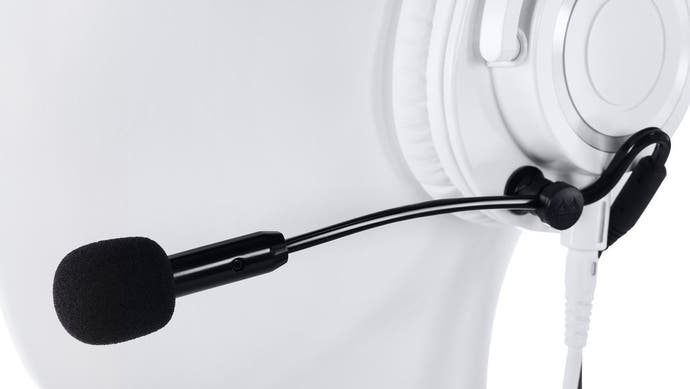
- Industry-leading audio quality, available in 3.5mm, USB or wireless versions
- Can be added to almost any gaming headset or headphones
- Requires a small amount of initial setup
The Antlion ModMic has long been recommended by tech insiders, and after testing out the £55/$55 ModMic Uni, £85/$80 ModMic USB and £140/$140 ModMic Wireless it's easy to see why - this family of mics sound better than pretty much every headset microphone on the market. Each can be installed on pretty much any set of headphones, using a small piece of adhesive. The bulk of the mic can be removed as needed, leaving just the small magnetic base you stuck on behind, and there are a couple of replacement bits of adhesive in the box if you want to move the mic to a new headset in the future.
Where the microphones differ is largely to do with how they connect to your PC or console. The ModMic Uni comes with a 3.5mm jack, like the ModMic 4 and ModMic 5 before it, while the ModMic wireless uses Bluetooth AptX Low Latency good for about twelve hours between recharges. The ModMic USB is the most advanced model, with a USB connection for PS4 and PC that allows Antlion to roll in their own sound processing to improve aural performance.
If you're on a budget, the lower cost ModMic Uni is the best choice, as it provides substantially better audio quality than any headset mic we've tested. We also recommend it for Xbox, or PC users with headphone amps or advanced sound cards. For PS4 or PCs with on-board audio, the better sonic performance of the ModMic USB makes it a worthy upgrade. Finally, the ModMic Wireless pairs best with wireless headsets, allowing you to recharge both headset and mic together while retaining a fully cable-free connection for gaming.
Frequently asked questions
What accessories are useful?
There are a range of accessories we could discuss, but the most important for newcomers are boom arms and pop filters.Rather than relying on the short stands included with many USB and XLR microphones, a proper adjustable arm makes it easier to position your microphone so that it picks up your voice without taking up too much of your screen (if you're playing a game) or your camera's point of view (if you're streaming). When adjusting your arm, take your microphone's style of address into account. Side-address microphones, like the Blue Yeti, work best when you're speaking into one side, while top address microphones should be pointed directly at your mouth. We used a Blue Compass arm and Radius 3 shock mount for testing these microphones, but there are many other options available at a range of price points.
Pop filters and wind shields are the next accessory you should consider, as they reduce the impact of plosives - sounds like p and b that are harsh on the ears if they are recorded by a bare microphone. Pop filters and wind shields are normally mounted onto your mic or boom arm, and need to be positioned between you and your mic to be effective.
For XLR mics, you'll also need an audio interface and an XLR male to female cable to hook up your microphone.
Is it better to use USB or XLR?
If you're just going to use your single mic at your PC, then a USB microphone is ideal - it's plug and play, with no extra equipment needed. XLR mics need to be connected via an audio interface, but these allow you to include other audio equipment like multiple microphones or mixers. If you're just starting out, USB is the way to go, while XLR may be a better choice for dedicated content creators that want room to grow into more advanced setups. You can also split the difference - pick up an XLR mic, but use a simple XLR to USB adapter until you bring in a proper audio interface.
Which platforms can I use these mics on?
The USB mics mentioned above will work pretty much out of the box on Windows, macOS, Linux, PS5 and PS4, while XLR mics will need to be connected to an adapter or interface with a USB output to achieve the same goal. The Xbox Series and Xbox One consoles don't support USB mics, unfortunately.


